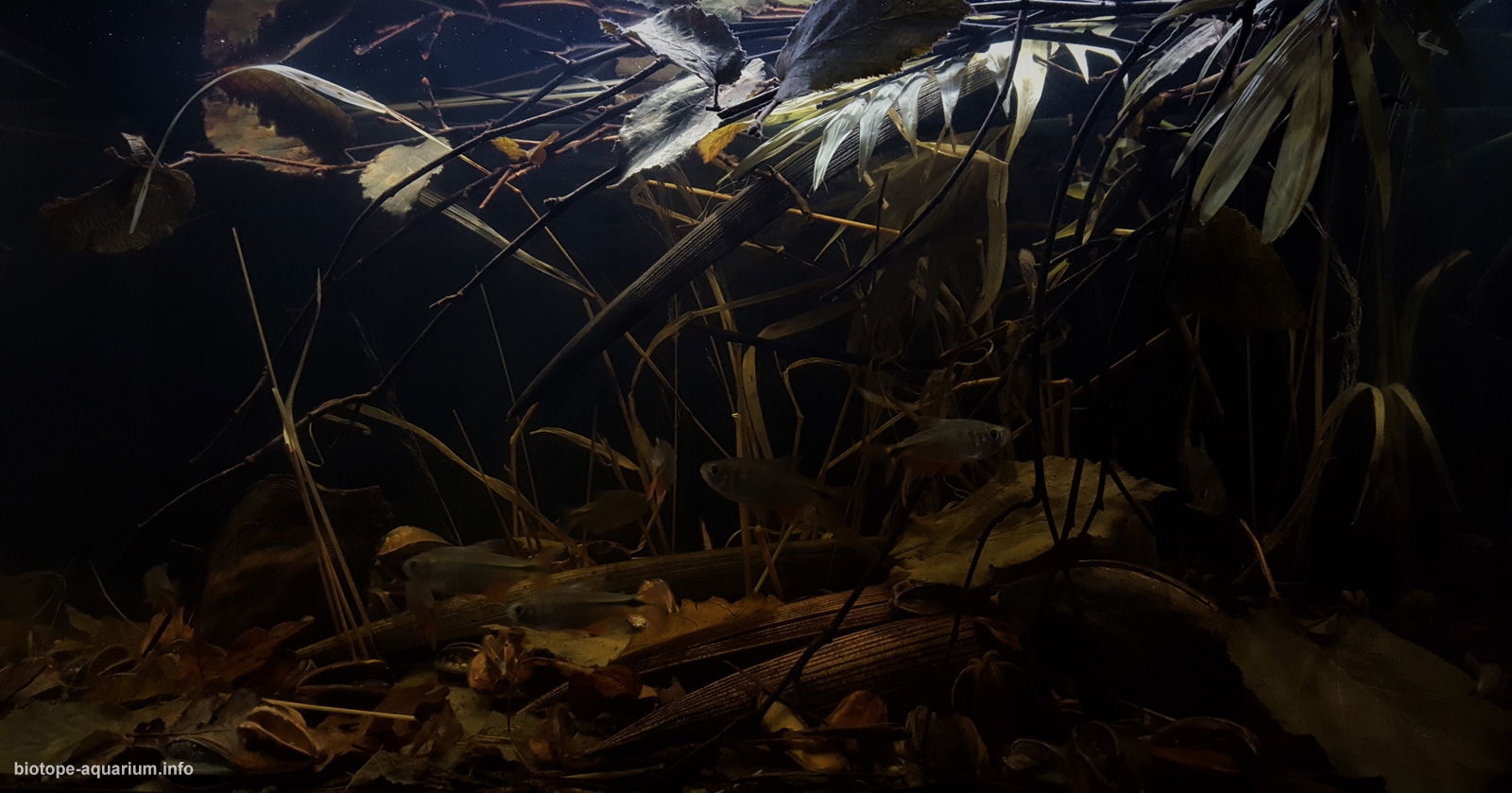Flooded waterfront of the Rio Ivaí, a branch of the Rio Parana
64th place in Biotope Aquarium Design Contest 2018
![]() Germany. Erik Schimpf
Germany. Erik Schimpf

Volume: 60 L
Dimensions: 60x35x30 cm
List of fishes: Hyphessobrycon anisitsi
List of plants: N/A
Description of decorations: To make the biotope as natural as possible, I collected old hazelnut wood that I had in the aquarium months ago (about a year ago). As the wood gradually decomposes, it develops a dark color similar to nature. So I use the bark of wood to cover and darken the floor. Because similar decomposition processes take place in rivers. However, I also have local varieties such as oak, hazelnut leaves and Brazilian fruits as well as Sororoca Tree Strelitzia fruits also use dried steppe grass to mimic a flooded waterfront. Chamaedorea graminifolia, as well as a simple hazel branch to imitate a drooping branch. Chamaedorea graminifolia, Strelitzia nicolai, Coconut Leaf, Fruto Cinzeiro, Qualea grandiflora, watered Hazelnut wood (Corylus sieboldiana), JBL Sansibar WHITE, several layers of Oak and Hazelnut leaves.
Description of equipment: Tetra EX 800 plus, 790 (lph)/ 230 V / 50 Hz, Wave Riviera Led Natural 220/240v
Water parameters: Temperature is 22 degrees Celsius, the pH value is 7.0, KH is 4.
INFORMATION ABOUT BIOTOPE
Description of the area surrounding the biotope: The Ivaí River (Portuguese, Rio Ivaí) is a river of Paraná state in southern Brazil. It is a tributary of the Paraná River. Its official spelling is Ivaí, with variants including Ivahy and Ival. The river basin is ecologically very degraded, with fragile and vulnerable soil. It contains the 8,716 hectares (21,540 acres) Perobas Biological Reserve, a strictly protected conservation unit created in 2006.
Description of the underwater landscape of the biotope: The river Ivaí is dark brown during the dry season. During the rainy season, the river turns into a torrent that regularly flooded parts of its catchment area. The riparian areas are thus flooded generously, so that large branches protrude into the water and thus offer the unique fauna a natural protection. For the competition, the water parameters were attenuated in terms of turbidity. Since the riparian area is heavily vegetated, branches, fruits and many leaves regularly fall to the ground, accumulate and form a thick layer and offer so many animals a wide food supply. Since the riparian area is exposed to strong changes due to different weather conditions, there are hardly any significant aquatic plants there.
Description of the parameters of the habitat: The water is dark brown impermeable and slightly muddy, the normal temperature varies between 24 and 28 degrees Celsius. The pH values are between 7.0 and 7.8. The water depth is 0.3 m to 15 m.
List of fishes and invertebrates occurring in the nature biotope: Hyphessobrycon bifasciatus, Laetacara dorsigera, Hyphessobrycon anisitsi, Corydoras paleatus, Aphyocharax anisitsi, Aphyocharax anisitsi, Platydoras costatus.
List of plants found in the nature biotope: In the place of the biotope, which I have described, there are no aquatic plants, except the forest-flooded plants.
Threats to the ecology: As in almost all countries of the world, in Paraguay there is a stark contrast between culture and nature. Not so long ago, the systematic deforestation and slash-and-burn of the jungle began. Today, the largest area of the country is used for agriculture and there are almost no pristine jungles and other natural landscapes. For some years, however, even the government of the country has recognized that it is important to protect the remaining areas and to create “new primeval landscapes”. The nature reserves distributed throughout the country are a first step in the right direction.
Sources of information:
http://pecessativos.blogspot.
https://www.biologie-seite.de/
https://de.wikipedia.org/wiki/
